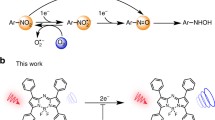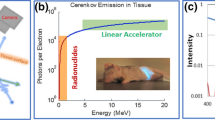Abstract
We present an approach based on photoacoustic lifetime imaging (PALI) to map the distribution of oxygen partial pressure (pO2) in tissue. This method utilizes methylene blue, a dye widely used in clinical applications, as an oxygen-sensitive imaging agent. PALI measurement of oxygen relies upon pO2-dependent excitation lifetime of the dye. The technique maps the excited triplet state of oxygen-sensitive dye, thus reflecting the spatial and temporal distributions of tissue oxygen.
Access this chapter
Tax calculation will be finalised at checkout
Purchases are for personal use only
Similar content being viewed by others
References
Shao Q (2016). Photoacoustic lifetime imaging and its biomedical applications. Dissertation, University of Minnesota
Punnoose J, Nachman H, Ashkenazi S (2022) Oxygen imaging for non-invasive metastasis detection. Sensors 22(1):237
Morgounova E, Johnson SM, Shao Q et al (2014) Lifetime-based photoacoustic probe activation modeled by a dual methylene blue-lysine conjugate. In: Photons plus ultrasound: imaging and sensing 2014, vol 8943. SPIE, p 812
Morgounova E, Johnson SM, Shao Q et al (2015) In vitro characterization of a lifetime-based activatable photoacoustic probe. In: Photons plus ultrasound: imaging and sensing 2015, vol 9312. SPIE, p 358
Shao Q, Merrill AB, Ashkenazi S (2014) Noninvasive tumor oxygen imaging by photoacoustic lifetime imaging integrated with photodynamic therapy. In: Optical methods for tumor treatment and detection: mechanisms and techniques in photodynamic therapy XXIII, vol 8931. SPIE, p 45
Shao Q, Morgounova E, Ashkenazi S (2015) Tissue oxygen monitoring by photoacoustic lifetime imaging (PALI) and its application to image-guided photodynamic therapy (PDT). In: Photons plus ultrasound: imaging and sensing 2015, vol 9323. SPIE, p 313
Shao Q, Morgounova E, Jiang C et al (2013) In vivo photoacoustic lifetime imaging of tumor hypoxia in small animals. J Biomed Opt 18(7):076019–076019
Shao Q, Ashkenazi S (2015) Photoacoustic lifetime imaging for direct in vivo tissue oxygen monitoring. J Biomed Opt 20(3):036004–036004
Author information
Authors and Affiliations
Corresponding author
Editor information
Editors and Affiliations
Rights and permissions
Copyright information
© 2024 The Author(s), under exclusive license to Springer Science+Business Media, LLC, part of Springer Nature
About this protocol
Cite this protocol
Shao, Q., Punnoose, J.G. (2024). Photoacoustic Lifetime Imaging of Hypoxia. In: Gilkes, D.M. (eds) Hypoxia. Methods in Molecular Biology, vol 2755. Humana, New York, NY. https://doi.org/10.1007/978-1-0716-3633-6_10
Download citation
DOI: https://doi.org/10.1007/978-1-0716-3633-6_10
Published:
Publisher Name: Humana, New York, NY
Print ISBN: 978-1-0716-3632-9
Online ISBN: 978-1-0716-3633-6
eBook Packages: Springer Protocols




